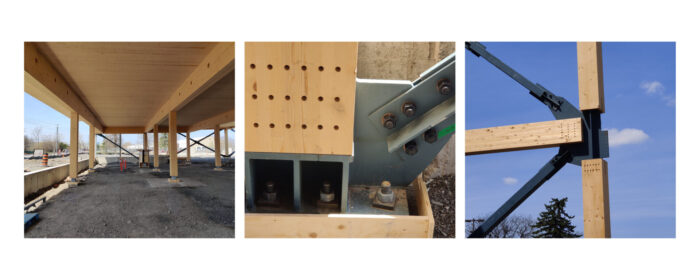Beautiful, conscientious, innovative, and unmistakably Canadian are mass timber structures we see emerging nationwide. Mass timber design provides an experience that can’t be replicated by steel or concrete. The wood provides a warm aesthetic that brings us back to nature while making strides toward sustainability. Our architects and engineers are proud to embrace and innovate timber designs that breathe life into our cities. As we continue to push towards sustainable practices in the building space, some unique attributes of timber are garnering attention. Continue reading to learn more about why we see mass timber as the future of design.
Reduces Embodied Carbon
Wood beams displace traditional high-carbon emitters such as steel and concrete, significantly reducing the embodied carbon associated with a project. Embodied carbon refers to greenhouse gas emissions from manufacturing, transporting, installing, and disposing of materials. When manufacturing steel, for example, the raw materials are mined requiring significant energy consumption and greenhouse gas emissions to convert iron ore into usable building materials. Together with sustainable forestry, mass timber can significantly reduce greenhouse gas emissions from the construction sector, accounting for 39% of all emissions globally. As a renewable resource, wood requires far fewer resources to extract and become ready for building, and the manufacturing process results in far less carbon emissions. Additionally, Mass timber structural elements are much lighter than traditional building materials such as steel or concrete. Due to its weight and local production, mass timber typically requires less energy in transportation costs. Plus, with responsible management, it can also be easily replanted and reproduced!
Promotes Health and Wellness
Mass timber is emerging as one of the many strategies revolutionizing the building industry as part of a climate change solution. Thanks to photosynthesis, the wood beams remove carbon dioxide (CO2) from the atmosphere and trap it during the lifetime of its usage. Additionally, mass timber is a biophilic design that connects people and nature within our built environments. The texture and warmth of exposed wood beams and floors provide a visually comforting environment, creating a calming and soothing effect while also improving humidity levels that benefit daily users.
Enhances the Construction Timeline
Mass timber designs are popping up across Canada for various projects, including commercial, institutional, multi-family residential, and more. What’s great about building with mass timber is that the systems are prefabricated off-site. Major building elements such as columns, beams, floor slabs, and more arrive at the construction site ready to be pieced together. Since the major components of a building can be quickly and easily assembled on-site, it significantly reduces the time it takes to build. Reducing construction timelines is both cost-saving and essential as the need for new buildings increases, and minimizing disruptions to urban centres is now crucial.
Exceeds Building Codes
There is a misconception that timber can be an unsafe building material – and we are here to dispel that myth! Mass timber structures meet and, in some cases, exceed building codes for fire protection. When Canadian building codes began to develop the requirements for mass timber use, mock-ups were designed to evaluate burn rates and fire performance. While many regulations require one to two hours of fire-resistance ratings, mass timber often surpassed this timeframe! Mass timber beams are difficult to ignite – think about how hard it is to light a large log on a campfire. Timber does not easily allow heat to pass through it. Instead, the wood chars from the outside, leaving a layer of charcoal and intact timber underneath. This process delays the spread to the remaining structure. As codes evolve to embrace mass timber construction, a leveling out of costs will follow as manufacturers respond to the uptick in demand. Our designers are already embracing its design, with Waterloo Region’s first modern building with a mass timber structural system and a series of commercial workspaces incorporating timber columns and beams. As demand for sustainable buildings increases, we look forward to providing our expertise in the future of mass timber design.


